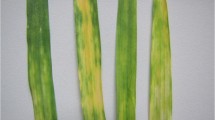Abstract
This study used molecular techniques to investigate the little-known characteristics of phytoplasmas in the semi-arid tropics of northern Australia in sesame, mung bean and peanut crops, and in adjacent non-crop species. Five new records of plant species associated with phytoplasma diseases are reported. No phytoplasmas were associated with fasciation but four phytoplasma strains were linked with other symptoms. Sweet potato little leaf variant Vinca 4, the most prevalent phytoplasma, was associated with symptoms of little leaf, or little leaf and phyllody, in all hosts (crop and non-crop species) except sesame, where it was most often associated with floral dieback. Tomato big bud was found only in sesame showing phyllody. Pigeon pea little leaf occurred in one mung bean and one peanut plant with little leaf and phyllody, and one non-crop species with yellowing and rosette formation. Waltheria little leaf was found in a single non-crop individual with little leaf and bunching symptoms. The findings show that adjacent non-crop species have the potential to function as reservoirs of phytoplasma disease for crop species but symptoms alone are not sufficient to diagnose specific phytoplasma strains.
Similar content being viewed by others
References
Crespi M, Vereecke D, Temmerman W, Vanmontagu M, Desomer J (1994) The fas operon of Rhodococcus fascians encodes new genes required for efficient fasciation of host plants. Journal of Bacteriology 176, 2492–2501.
Davis RI, Schneider B, Gibb KS (1997) Detection and differentiation of phytoplasmas in Australia. Australian Journal of Agricultural Research 48, 535–544.
Davis RE, Sinclair WA (1998) Phytoplasma identity and disease etiology. Phytopathology 88, 1372–1376.
Deng S, Hiruki C (1991) Amplification of 16S rRNA genes from culturable and nonculturable mollicutes. Journal of Microbiological Methods 14, 53–61.
Doyle JJ, Doyle JL (1990) Isolation of plant DNA from fresh tissue. Focus 12, 13–15.
Kaixuan J, Yue W (1992) MLO and BLO associated with fasciated tree diseases in China. International Journal of Tropical Plant Diseases 10, 209–213.
Lee I-M, Davis RE (1992) Mycoplasmas which infect plants and insects. In ‘Mycoplasmas: molecular biology and pathogenesis’. (Eds J Maniloff, RN McElhaney, LR Finch and JB Baseman) pp. 379–390. (American Society for Microbiology: Washington DC)
Liefting LW, Padovan AC, Gibb KS, Beever RE, Andersen MT, Newcomb RD, Beck DL, Forster RLS (1998) ‘Candidatus Phytoplasma australiense’ is the phytoplasma associated with grapevine yellows, papaya dieback and Phormium yellow leaf diseases. European Journal of Plant Pathology 104, 619–623.
McCoy RE, Caudwell A, Chang CJ, Chen TA, Chiykowski LN, Cousin MT, Dale JL, de Leeuw GTN, Golino DA, Hackett KJ, Kirkpatrick BC, Marwitz R, Petzold H, Sinha RC, Sugiura M, Whitcomb RF, Yang IL, Zhu BM, Seemüller E (1989) Plant diseases associated with mycoplasmalike organisms. In ‘The Mycoplasmas., Vol. V: Spiroplasmas, Acholeplasmas and Mycoplasmas of Plants and Arthropods’ (Eds RF Whitcomb and JG Tully) pp. 545–640. (Academic Press: San Diego)
Murral DJ, Nault LR, Hoy CW, Madden LV, Miller SA (1996) Effects of temperature and vector age on transmission of two Ohio strains of aster yellows phytoplasma by the aster leafhopper (Homoptera, Cicadellidae). Journal of Economic Entomology 89, 1223–1232.
Nakashima K, Hayashi T, Chaleeprom W, Wongkaew P, Sirithorn P (1995) Detection of DNA of phytoplasmas associated with phyllody disease of sesame in Thailand. Annals of the Phytopathological Society of Japan 61, 519–528.
Nakashima K, Murata N (1993) Destructive plant diseases caused by mycoplasma-like organisms in Asia. Outlook on Agriculture 22, 53–58.
Raychaudhuri SP, Mitra DK (1993) ‘Mollicute diseases of plants.’ (International Science Publisher: New York)
Sambrook J, Fritsch EF, Maniatis T (1989) ‘Molecular cloning, a laboratory manual.’ (Cold Spring Harbor Laboratory Press: Cold Spring Harbor, New York)
Schneider B, Cousin MT, Klinkong S, Seemüller E (1995a) Taxonomic relatedness and phylogenetic positions of phytoplasmas associated with diseases of faba bean, sunnhemp, sesame, soybean, and eggplant. Zeitschrift für Pflanzenkrankheiten und Pflanzenschutz-Journal of Plant Diseases & Protection 102, 225–232.
Schneider B, Gibb KS, Padovan A, Davis RI, De La Rue S (1999a) Comparison and characterisation of tomato big bud- and sweet potato little leaf-group phytoplasmas. Journal of Phytopathology 147, 31–40.
Schneider B, Padovan A, De la Rue S, Eichner R, Davis R, Bernuetz A, Gibb K (1999b) Detection and differentiation of phytoplasmas in Australia: an update. Australian Journal of Agricultural Research 50, 333–342.
Schneider B, Seemüller E, Smart CD, Kirkpatrick BC (1995b) Phylogenetic classification of plant pathogenic mycoplasmalike organisms or phytoplasmas. Molecular and Diagnostic Procedures in Mycoplasmology 1, 369–380.
Sears BB, Kirkpatrick BC (1994) Unveiling the evolutionary relationships of plant-pathogenic mycoplasmalike organisms. American Society for Microbiology News 60, 307–312.
Seemüller E, Marcone C, Lauer U, Ragozzino A, Goschl M (1998) Current status of molecular classification of the phytoplasmas. Journal of Plant Pathology 80, 3–26.
Stange RR, Jeffares D, Young C, Scott DB, Eason JR, Jameson PE (1996) PCR amplification of the fas-1 gene for the detection of virulent strains of Rhodococcus fascians. Plant Pathology 45, 407–417.
Sylvester ES (1985) Multiple acquisition of viruses and vector dependent prokaryotes: consequences on transmission. Annual Review of Entomology 30, 71–88.
Wongkaew P, Hanboonsong Y, Sirithorn P, Choosai C, Boonkrong S, Tinnangwattana T, Kitchareonpanya R, Damak S (1997) Differentiation of phytoplasmas associated with sugarcane and gramineous weed white leaf disease and sugarcane grassy shoot disease by RFLP and sequencing. Theoretical & Applied Genetics 95, 660–663.
Author information
Authors and Affiliations
Corresponding author
Rights and permissions
About this article
Cite this article
Wilson, D., Blanche, K.R. & Gibb, K.S. Phytoplasmas and disease symptoms of crops and weeds in the semi-arid tropics of the Northern Territory, Australia. Australasian Plant Pathology 30, 159–163 (2001). https://doi.org/10.1071/AP01015
Received:
Accepted:
Issue Date:
DOI: https://doi.org/10.1071/AP01015



